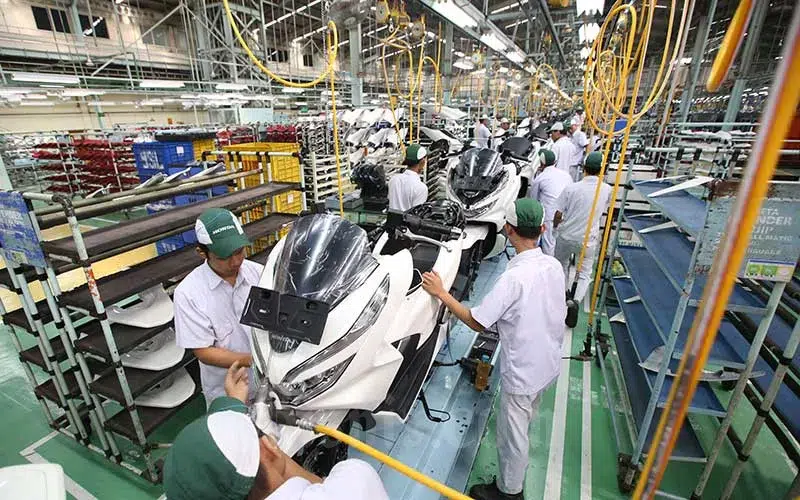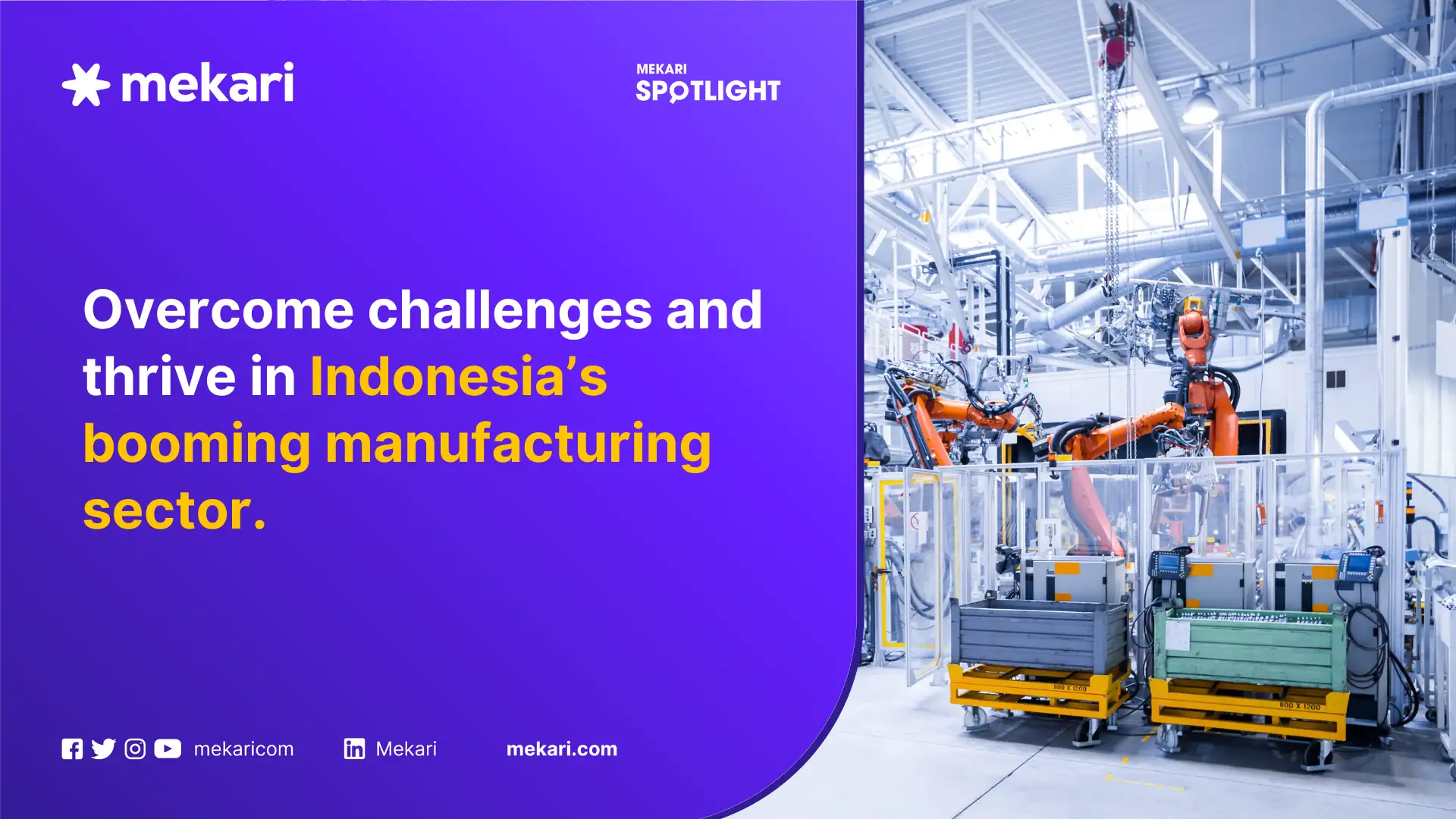Mekari Insight
- Indonesia’s manufacturing sector, contributing around 20% to the nation’s GDP, offers significant growth potential making it an attractive destination for foreign investors.
- While challenges like operational inefficiencies, supply chain disruptions, and complex regulations exist, they can be effectively managed with a clear strategy and local insight.
- Leveraging integrated SaaS platforms such as Mekari enables businesses to streamline operations, improve decision-making, and stay competitive in Indonesia’s fast-evolving manufacturing landscape.
The manufacturing sector remains a fundamental pillar of Indonesia’s economy, contributing approximately 20% to the nation’s GDP in 2023.
For foreign investors eyeing opportunities in Southeast Asia, Indonesia manufacturing presents significant potential driven by its expanding market and strategic advantages.
However, tapping into this growth requires a clear understanding of the unique challenges involved. Read this guide to help you optimize operations and ensure successful investment in Indonesia’s manufacturing industry.
Indonesia’s manufacturing industry outlook
Indonesia’s manufacturing sector continues to show strong resilience, consistently recording positive numbers in the Purchasing Managers’ Index (PMI). In early 2025, the PMI climbed to 51.9 in January and rose further to 53.6 in February, signaling steady growth and growing confidence among businesses.
This momentum is mainly driven by rising domestic demand, with new export orders also playing a supporting role.
Looking ahead, the government has set an ambitious target to grow the economy by 8% annually between 2025 and 2029. The industrial sector is central to this plan, with hopes that the non-oil and gas manufacturing sector alone will contribute 8.58% to GDP by 2029.
Read more: Top 10 Fastest-Growing Industries in Indonesia (2025 Edition)Major industry segments in Indonesia manufacturing
Here’s a quick look at the main industries shaping this landscape:
- Food and beverages: Utilizes abundant agricultural resources to produce packaged foods, drinks, and halal products, driven by strong domestic demand and health-conscious consumers.
- Pharmaceuticals: Produces medicines, vaccines, and supplements, supporting Indonesia’s healthcare needs and relying on inputs from the chemical sector.
- Chemical: Supplies fertilizers, preservatives, plastics, and cleaning products, serving as a key foundation for agriculture, pharma, and industrial manufacturing.
- Metals and machinery: This sector supports Indonesia’s infrastructure development, with rising demand for industrial equipment aligning with national modernization plans.
- Textile: Indonesia’s textile industry remains competitive due to its skilled workforce and focus on integrated manufacturing, positioning it well in global supply chains.
- Automotive: A regional hub for assembling vehicles and parts, with growing focus on electric vehicles fueled by Indonesia’s nickel resources.
- Electronics: Assembles consumer electronics and automotive components, driven by digital growth and emerging technologies like IoT and AI.
Read more: 10 Things you Should Know Before Doing Business in IndonesiaIndonesia manufacturing landscape
To fully appreciate Indonesia manufacturing’s potential, it’s important to understand the key factors shaping its growth.
1. Economic growth & domestic demand
Indonesia has a vibrant and growing domestic market of over 275 million people, supported by steady economic growth averaging around 5% annually, with 5.03% projected in 2024.
This means strong consumer demand across many manufacturing sectors, from food and beverages to electronics and automotive. Even with some concerns about shifts in middle-class size, the overall trend points to solid opportunities for manufacturers focused on serving local consumers.
2. Strategic location & connectivity
Nestled between the Indian and Pacific Oceans, Indonesia’s geography is a major asset. Its vast archipelago offers natural ports and easy access to key Asian markets.
As global companies look to diversify supply chains, Indonesia stands out as a prime alternative manufacturing hub—especially given today’s complex geopolitical landscape.
3. Government support & initiatives
The Indonesian government actively promotes industrial growth through initiatives like “Making Indonesia 4.0,” a roadmap to transform the nation into a global manufacturing powerhouse by adopting technologies such as AI, IoT, and robotics.
This plan focuses on five priority sectors—food and beverages, textiles and apparel, automotive, chemicals, and electronics.
To encourage foreign investment, the government offers incentives like tax holidays, import duty exemptions, and streamlined licensing in Special Economic Zones. Manufacturing investment hit IDR 721.3 trillion in 2024, reflecting strong growth.
4. Abundant workforce

With over 140 million people, Indonesia boasts a young and sizeable workforce ready to support manufacturing growth. While skill development is ongoing, this large labor pool offers a clear advantage in both cost and availability.
Combined with government-led vocational training, Indonesia’s workforce is a strong foundation for expanding both basic and advanced manufacturing industries.
5. Rich natural resources

Indonesia is blessed with a wealth of natural assets that underpin many manufacturing industries.
From being a major supplier of palm oil, rubber, and coal to producing a wide variety of agricultural products, the country offers a reliable source of raw materials for sectors like food processing and chemicals.
6. Attractive option for production diversification
Global companies adopting the ‘China Plus One’ strategy are increasingly considering Indonesia as a key alternative manufacturing location.
Its resource richness, strategic position, and improving business conditions position it well as a preferred choice for diversifying production bases.
Read more: Business Expansion to Indonesia: 8 Reasons & Complete StrategyNavigating the challenges in Indonesia manufacturing
While Indonesia’s manufacturing sector offers significant promise, it also comes with its own set of challenges that can impact productivity and growth.
1. Operational inefficiencies
Many manufacturers, especially SMEs, struggle with disconnected systems across departments such as production, finance, and HR. This fragmentation leads to manual work, mistakes, and delays.
For example, when production data isn’t linked to inventory in real time, companies risk having too much or too little stock, which can hurt cash flow and customer satisfaction. Without integrated workflows, it’s hard to get a clear view of operations and make improvements.
2. Supply chain instability
Indonesia’s geographic layout and dependence on imported raw materials make its supply chains vulnerable to disruptions. Logistics costs remain high, partly due to the archipelago’s challenging transportation networks, which can cause delays and added expenses.
These factors make it difficult to maintain steady production, especially when global events affect material availability and shipping routes.
3. Talent shortages and skill gaps
Despite having a large labor force, manufacturers often find it difficult to recruit and retain workers with the right skills for modern, technology-driven manufacturing.
The country’s push toward Industry 4.0 means companies need more digital and analytical capabilities, but workforce development hasn’t kept pace. This mismatch creates challenges in adopting new technologies and maintaining competitiveness.
4. Complex regulatory environment
Indonesia’s regulatory framework can be confusing and time-consuming. Frequent changes to tax laws, permits, and compliance requirements add uncertainty and administrative burdens.
Even with reforms like the Omnibus Law intended to ease regulations, manufacturers must carefully navigate rules related to labor, product standards, and the environment to avoid penalties or operational setbacks.
5. Data fragmentation and lack of real-time insight
Data scattered across various systems without integration leads to silos that prevent manufacturers from seeing the full picture.
This lack of real-time, comprehensive information limits their ability to make quick, informed decisions, anticipate demand, and optimize production. It also hampers the use of advanced technologies like AI for predictive maintenance or smart factory initiatives.
Streamline manufacturing operations with top manufacturing software in Indonesia
To truly optimize your manufacturing operations in Indonesia, you need solutions that understand the unique challenges and opportunities of this vibrant market. Indonesia’s manufacturing sector is bursting with potential for foreign businesses ready to grow and succeed.
Mekari offers an all-in-one platform designed to simplify every part of your manufacturing operation—from supply chain to finance and HR—so you can focus on what matters most: building and expanding your business.
Ready to unlock the full potential of Indonesia’s manufacturing industry? Find out how Mekari can help you get there.
Reference
Pro QC. ”Manufacturing in Indonesia: Opportunities, Challenges, and Product Quality”

